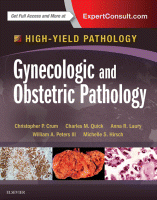Physical Address
304 North Cardinal St.
Dorchester Center, MA 02124

D efinition —A benign adnexal tumor with eccrine differentiation. Clinical Features Epidemiology Higher incidence in women and Asians. More frequently identified in trisomy 21 patients. You’re Reading a Preview Become a Clinical Tree membership for Full access and enjoy Unlimited…

PITFALL D efinition —An unusual benign adnexal tumor that exhibits both apocrine and eccrine differentiation and occurs almost exclusively in the vulva. Clinical Features Epidemiology Uncommon. Nearly always seen in postpubertal, but premenopausal, adult women. More frequent in Caucasians. You’re…

D efinition —Tumor of mammary phenotype arising in ectopic breast tissue. Clinical Features Epidemiology Rare. The most popular theory is that this tumor arises in a rudiment of mammary tissue (in the “milk line”) that did not completely regress during…

D efinition —Adnexal tissue with mammary differentiation in the vulvar region. Clinical Features Epidemiology Rare. The most popular theory is that it reflects a rudiment of caudal mammary buds (in the “milk line”) that did not completely regress during development.…

D efinition —Vaginal cyst of müllerian origin. Clinical Features Epidemiology Relatively uncommon. Derived from müllerian remnants. Wide age range with a median in the fourth decade. You’re Reading a Preview Become a Clinical Tree membership for Full access and enjoy…

D efinition — Cyst formation follows occlusion of Bartholin's duct, which drains Bartholin's glands. Clinical Features Epidemiology Common lesions that happen in all age groups. You’re Reading a Preview Become a Clinical Tree membership for Full access and enjoy Unlimited…

D efinition —Infection by the neurotropic varicella-zoster virus (VZV), an alpha-herpesvirus. Clinical Features Epidemiology Primary VZV infection, commonly known as chickenpox, occurs predominantly in children. Recurrences occur later in life. Severe, recurrent infections can be seen in the setting of…

D efinition —An aggressive infection of the subcutis and fascia. Clinical Features Epidemiology Commonly seen in the setting of diabetes. Predisposing factors include obesity, hypertension, immune compromise, and history of previous trauma. You’re Reading a Preview Become a Clinical Tree…

D efinition —An opportunistic infection that commonly occurs in the backdrop of human immunodeficiency virus (HIV)/AIDS infection caused by the organisms Bartonella henselae or Bartonella quintana . Clinical Features Epidemiology This is a rare, opportunistic disease seen in immunocompromised individuals.…

D efinition —Infection by trematodes that belong to the superfamily schistosomatidae ( Schistosoma haematobium , Schistosoma japonicum , and Schistosoma mansoni ). Clinical Features Epidemiology Endemic in Egypt and the Middle East. Genital lesions occur in approximately 5% of patients…